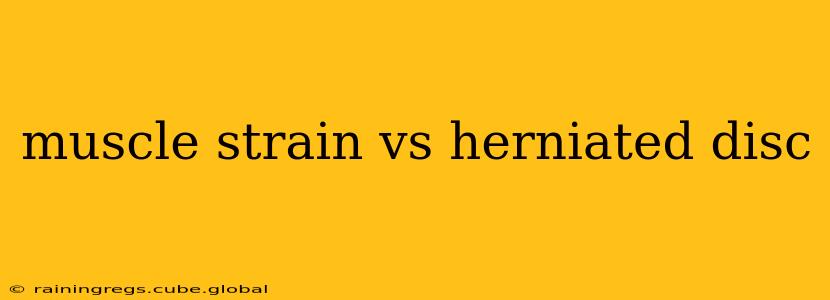Back pain is a common ailment, affecting millions worldwide. Two frequent causes of lower back pain are muscle strains and herniated discs. While both can cause significant discomfort, they have different underlying causes, symptoms, and treatments. Understanding the distinctions is crucial for proper diagnosis and effective management. This comprehensive guide will explore the key differences between muscle strains and herniated discs, helping you better understand your back pain.
What is a Muscle Strain?
A muscle strain, also known as a pulled muscle, occurs when muscles in the back are overstretched or torn. This often happens due to sudden movements, heavy lifting, or repetitive strain. The severity of a muscle strain can range from mild discomfort to intense pain, depending on the extent of the damage.
Symptoms of a Muscle Strain:
- Localized pain: Pain is typically felt in the affected muscle, often improving with rest.
- Muscle spasms: Involuntary contractions of the muscle can occur.
- Tenderness to the touch: The affected area may feel sore or painful when pressed.
- Limited range of motion: Difficulty bending, twisting, or extending the back may be present.
- Swelling: Mild swelling might be noticeable around the injured muscle.
What is a Herniated Disc?
A herniated disc, also known as a slipped or ruptured disc, occurs when the soft, gel-like center of an intervertebral disc pushes through a tear in the tougher outer layer. These discs act as cushions between the vertebrae in your spine. A herniation can put pressure on nearby nerves, resulting in pain, numbness, or weakness.
Symptoms of a Herniated Disc:
- Pain radiating down the leg (sciatica): This is a common symptom, often felt in the buttock, leg, and foot on one side.
- Numbness or tingling: These sensations can occur in the leg or foot.
- Muscle weakness: Weakness in the leg or foot may develop.
- Pain that worsens with certain movements: Activities like bending, lifting, or coughing can exacerbate the pain.
- Pain that may not improve with rest: Unlike muscle strains, herniated disc pain can be persistent and less responsive to rest.
Muscle Strain vs. Herniated Disc: Key Differences Summarized
| Feature | Muscle Strain | Herniated Disc |
|---|---|---|
| Cause | Overstretched or torn muscle | Ruptured intervertebral disc |
| Pain Location | Localized to the affected muscle | Can radiate down the leg (sciatica) |
| Radiation | Typically no radiation of pain down the leg | Often radiates pain down the leg |
| Numbness/Tingling | Usually absent | Often present in the leg or foot |
| Weakness | Usually absent | Often present in the leg or foot |
| Response to Rest | Often improves with rest | May not improve significantly with rest |
How are Muscle Strains and Herniated Discs Diagnosed?
Diagnosing these conditions usually involves a physical examination by a doctor or physical therapist. They'll assess your range of motion, palpate the affected area, and ask about your symptoms. Imaging tests, such as X-rays, MRIs, or CT scans, may be ordered to confirm the diagnosis, particularly for suspected herniated discs.
How are Muscle Strains and Herniated Discs Treated?
Treatment for both conditions varies depending on the severity of the symptoms. Options include:
- Rest: Avoiding activities that aggravate the pain.
- Ice and heat: Applying ice initially to reduce inflammation, followed by heat to relax muscles.
- Over-the-counter pain relievers: Medications like ibuprofen or acetaminophen can help manage pain and inflammation.
- Physical therapy: Exercises to strengthen muscles and improve range of motion.
- Prescription medications: In some cases, stronger pain relievers or muscle relaxants may be prescribed.
- Injections: Epidural steroid injections may be used to reduce inflammation in cases of herniated discs.
- Surgery: Surgery is rarely necessary for muscle strains, but it may be considered for severe or unresponsive herniated discs.
What are the Long-Term Outcomes?
Most muscle strains heal within a few weeks with proper rest and treatment. Herniated discs can take longer to heal, and some individuals may experience persistent pain or require ongoing management. The prognosis varies depending on the severity of the herniation and individual factors.
Can a Muscle Strain Lead to a Herniated Disc?
While not directly causative, repeated muscle strains or chronic muscle imbalances can put additional stress on the spinal discs, potentially increasing the risk of a herniated disc over time. Maintaining good posture, proper lifting techniques, and regular exercise are crucial for preventing both conditions.
How Can I Prevent Muscle Strains and Herniated Discs?
Prevention is key! Here are some helpful tips:
- Maintain good posture: Proper posture reduces strain on your back.
- Strengthen your core muscles: Strong core muscles provide better support for your spine.
- Lift objects correctly: Bend at your knees and lift with your legs, not your back.
- Maintain a healthy weight: Excess weight puts extra pressure on your spine.
- Get regular exercise: Regular exercise improves muscle strength and flexibility.
- Stretch regularly: Stretching can help prevent muscle stiffness and strains.
This information is for general knowledge and does not constitute medical advice. Always consult with a healthcare professional for diagnosis and treatment of any medical condition.
